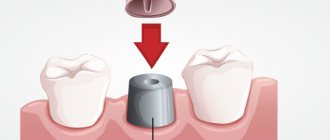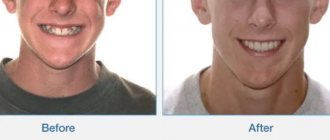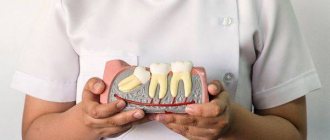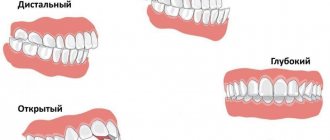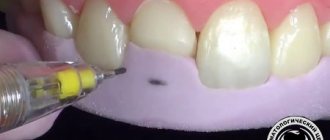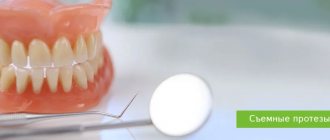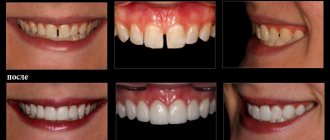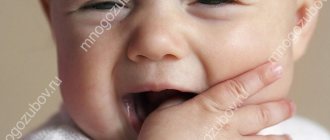When and how do the upper teeth cut?
Teeth, including the upper ones, are not cut all at once. They have certain deadlines. But they begin to torment long before they pass through the bone and pierce the soft tissue of the gums. This is how the human body works. But there is no point in blaming nature or the higher mind that invented it all. You need to think about what to do to alleviate the condition in the process.
- From approximately the sixth to the ninth month, the lower (first) incisors erupt. The process is accompanied by a lot of unpleasant sensations.
- From the seventh to the tenth month of life, the upper (first) incisors appear in the baby's mouth. The consequences are the same.
- From the ninth month to one year, the upper and lower second incisors appear in the mouth.
- Lastly, at the age of one and a half to two years, the upper and lower canines are cut.
Teething pattern
Which teeth come out first in a child - diagram
Every mother eagerly awaits the moment when her baby’s first teeth grow. In a newborn, this process can begin at different times. There are babies whose gums swell at 2 months, and at 4 months they already have primary incisors. It’s worth knowing which teeth a child’s teeth come in first, and how many of them a child should have by the age of one or two years, in order to avoid any unpleasant moments later.
What accompanies the eruption of baby teeth?
A list of “suffering, pain and sleepless nights for parents” would be suitable here, as well as constant trips to doctors, buying a bunch of necessary and unnecessary medications... But I want to write about what you really need to know.
Teething is a painful process
The fact that the child will be hurt is clear even without me. When a piece of bone protrudes through the gums, it is difficult not to notice this process. The gums immediately begin to become inflamed, and bacteria multiply in the mouth. If we talk about other symptoms of teething in the upper teeth, it is worth remembering that this condition is often accompanied by a significant increase in temperature. The child may lose appetite. Still, how can you eat normally when your mouth hurts?
Children immediately begin to put their hands and various objects into their mouths, which always ends with another classic childhood problem - stomatitis.
Baby teether
In general, stomatitis and gingivitis (inflamed gums) are classics of the genre during this period. Dysbacteriosis following this process can lead to intestinal problems. Hence - diarrhea and vomiting.
If inflammation of the gums during teething of the upper teeth can be eliminated by rinsing with decoctions of chamomile, sage and other natural remedies, then they relieve pain only slightly.
- If a white coating appears in your mouth, it means that a fungus has developed that causes candidal stomatitis.
White coating on the tongue - Temperatures from 37 to 38.5 degrees are common.
If it rises to 39 or more, call an ambulance. It is quite possible that some kind of inflammatory process has occurred. And such temperatures are poorly tolerated at such a young age. The child has a fever - Diarrhea is not a symptom of teething, but a sign that there are fewer “good” bacteria than harmful ones. And not only in the mouth, but also in the digestive system. This needs to be fixed.
Relieving teething symptoms
How to understand that teeth are cutting? Timing and order of tooth growth
Why is a child not born with teeth right away? Surely all mothers have asked this question. Not only does no one know when to expect teeth to appear in each individual child, but this process is often accompanied by pain, fever and whims in the baby.
Register and get access to all articles by our experts in the “ProgramMama” application
The rudiments of the teeth in the fetus are formed at 6-7 weeks of pregnancy, and come out no earlier than three months of the baby’s life. Although there are cases when a newborn is born with one or more teeth, this is a very rare case - 5 children out of 10,000. There is another variant of the norm: in some babies, the first tooth appears after 12 months.
Factors influencing delayed dental growth in children under 1 year of age
- hereditary predisposition (if mom and dad got teeth late, then perhaps their children will have the same);
- lack of calcium and vitamin D (rickets);
- excessive fluoride intake;
- hormonal disorders associated with improper functioning of the thyroid gland (hypothyroidism);
- absence of tooth buds (edentia).
Teething is a rather difficult, labor-intensive process for the entire body. Immediately after birth, the baby begins to accumulate vitamins and minerals for the appearance of such important chewing organs. Therefore, it is important for a breastfeeding mother to eat a healthy and balanced diet. Then the tooth itself needs to go through the bony membranes of the gums to see the light.
Different children react differently to the appearance of teeth. Some mothers find out that their child’s first incisor has grown by the white tubercle on the lower jaw, while others bring down the baby’s high fever, soothe inflamed gums, and do not remove the child from the potty due to diarrhea long before the first tooth appears.
Doctors cannot unequivocally answer the question of why such differences exist in initially healthy children, even in the 21st century. During the observation of children in various countries, they derived the average principles of dental growth in infants. First, the teeth come out in pairs. When the right lower incisor comes out, wait for its left neighbor next. Although some children, or rather their parents, are especially “lucky”: they get 3-4 teeth at once. Secondly, the lower teeth come out first, and then their upper twin brothers. The exception is the lateral incisors: the upper representatives are the first to see the light and only then let the lower comrades in.
The order of teething in children
- Central incisors (appear on average from 6 months);
- Lateral incisors (can be seen from 9 months);
- First molars (a common gift for a child's first birthday);
- Fangs (by about 1.5 years);
- Second molars (closer to 2 years).
Experts have derived a conditional formula for how many teeth a baby should have by a certain age: “The number of teeth = the child’s age in months minus 6.”
Teething symptoms
- swelling of the gums;
- tearfulness, crying, poor sleep;
- fever for 2-3 days;
- diarrhea;
- runny nose.
When these signs appear, it is important not to self-medicate, but to contact a qualified specialist so as not to mistake a real illness for harbingers of teeth. Most childhood respiratory diseases, intestinal infections and viruses are accompanied by the same symptoms and it is important to start treatment on time.
Read in our blog: “How to deal with otitis media in children”
When your child is one year old, it is necessary to show him or her a dentist. He will check whether the teeth are growing correctly and the bite is forming. He will definitely look at whether the teeth are growing in a certain arc and give recommendations for daily oral care. If the baby’s mouth is empty after 12 months, then this is also a reason to consult a doctor.
Some grandmothers may advise you not to brush your baby teeth, because they will fall out anyway. But this is not true: temporary teeth stand in the place of permanent ones, and the loss of even one bone soldier threatens to disrupt order in the entire ranks. Teeth can move out of place, and new ones will grow in a “crooked fence.” You can brush your very first teeth with a silicone fingertip and gradually switch to a real brush and baby toothpaste.
Think of your first tooth not as a problem, but as a joy. After all, this is a big step towards growing up your baby. Soon he will no longer be a helpless little baby, but will become an independent person with a snow-white smile.
We tell and show everything about how to care for a child, about his health and development in the video course “The baby is born. What's next?"
Medicines that can be given to a child
When children develop a fever, they are usually given paracetamol. Only now there is a whole stack of scientific articles with authoritative sources that talk about how dangerous this drug is for babies. It is associated with asthma symptoms, breathing problems and many other complications. To risk? Of course, I am not a doctor, but I would not conduct such experiments on my child.
Paracetamol
The second thing that mothers and fathers usually think about, as well as pediatricians, is how to relieve pain. The process of teething the upper teeth in infants is too painful.
In 9 cases out of 10, medications prescribed to children may contain lidocaine.
There are also a lot of articles on why you shouldn’t use them, including a report by the American Food and Drug Review Organization. If we simplify everything to the point of banality, then this is what comes out. No gel can quickly absorb and stay on wet gums. As a result, part of the substance ends up under the tongue, and part is swallowed. The baby begins to drool because his tongue is numb, and if he swallows the anesthetic, he may face an even greater danger - the substance getting into the throat and respiratory tract.
Baby is drooling
As soon as the swallowing reflex is blocked or breathing problems arise... I won’t continue further, because it’s scary to even think about it. Therefore, let’s ask what is the safest to use.
Cholisal is often recommended. It is less harmful, but the instructions clearly state that children under one year of age should be used with caution. Mundizal has the same composition, only it is produced by a different company.
"Cholisal gel"
The popular Dentinox gel also contains lidocaine.
Dentokind
If you want something less harmful, there is, for example, Dentokind. It is homeopathic with chamomile and belladonna. Relieves inflammation and generally has a “calming” effect. For teething upper teeth in children under one year old, this is an excellent option. If you combine this remedy with regular rinsing of your mouth with solutions of soda, chlorhexidine and iodinol, you can achieve significant relief, and at the same time get rid of accompanying stomatitis. Overall, the recipe is simple and affordable.
However, no matter how confident you are in yourself, your knowledge and the help of the omniscient Google, do not neglect the help of an experienced pediatrician and pediatric dentist.
Teeth cutting: how to help your child
There are a lot of products that only doctors and pharmacists know about, but you and I have never even heard of. It's worth trying your luck. Suddenly they will prescribe you something that is not very expensive and at the same time quite effective.
So, if your child’s temperature starts to rise, loss of appetite, problems with normal sleep and digestion, don’t play know-it-all, but call the doctor or take your baby to the clinic. This makes it much more likely that you will resolve the issue faster and safer for your health.
Which teeth come out first in a child?
If we exclude possible disturbances in the functioning of the body and other factors that affect teething, then in a significant number of children, teeth should appear in the following order according to the scheme:
| Name | Localization location | Period of eruption |
| 1. Lower central incisors | Middle of the lower jaw | 6-7 months |
| 2. Upper central incisors | Erupts in the middle of the upper jaw | 8-11 months |
| 3. Upper lateral incisors | They come out behind the central incisors | 9-12 months |
| 4. Lower lateral incisors | Located behind the central incisors | 11-14 months |
| 5. Upper first molars | Climb through the gap after the lateral incisors | 12-16 months |
| 6. Lower first molars | Appears after the lateral incisors | 12-16 months |
| 7. Fangs | Grows between the lateral incisors and first molars | 17-20 months |
| 8. Second molars | They climb immediately after the first molars | 2.5-3 years |
Often, the baby's lateral incisors or canines are cut first. But this is no reason to worry.
Before the first incisors appear, some mothers complain of the following symptoms:
- Swelling and redness of the gums;
- The baby's desire to gnaw or chew something;
- Increased body temperature;
- Intestinal disorder;
- Whims;
- Restless, short sleep;
- Increased salivation;
- Swelling in the cheek area;
- Nasal congestion or, conversely, excessive discharge;
Most of the manifestations are similar to the symptoms of well-known colds. In order to rule out ARVI, influenza and other colds, you need to make an appointment with your local pediatrician.
Each child experiences this period individually. Some have pronounced symptoms, while others have none at all. The change of the first incisors occurs at 5-8 years.
Diagram of baby teeth eruption in babies
How to help with teething?
The appearance of fangs is a difficult period for a child; he or she is constantly bothered by itching, burning and pain. Eliminating unpleasant symptoms is not an easy task. However, there are many tips that can help your child overcome teething more easily.
Special teethers
First, you need to provide your baby with a variety of teethers, which are filled with liquid or gel inside. Teethers are designed to cool the gums and prevent itching. Such devices must be placed in the refrigerator from time to time to restore their effect. You can also use pacifiers and bottles, which also satisfy the baby's chewing needs.
It is necessary to select pacifiers of a special orthodontic shape and high quality. Incorrectly chosen pacifiers can cause the development of malocclusion. Maintain cleanliness and proper storage of these devices.
Additionally, you can massage the child’s gums with gauze swabs moistened with cold water. This relieves pain and eliminates bacteria from the mouth.
Medications
Medicines are the most effective helpers. There are many ointments, gels and other products. The most commonly used medications that have been tested over the years are:
- Dentinox is a gel containing chamomile and lidocaine that acts as an anesthesia. Use three times a day, there may be side effects such as allergies.
- Baby Doctor first teeth - has an anti-inflammatory effect. Suitable for infants.
- Homeopathy - Dantinorm baby - provides a complex effect, relieves pain, fights digestive disorders, removes inflammation.
The use of any drug should be done after consulting a doctor.
Every mother faces the period when her baby is teething. The process is unpleasant and painful, but you need to go through it with dignity and patience together with your children, helping them in every possible way to cope with pain and fever.
If the appearance of teeth in a baby is delayed, this is due to inhibition of growth and development. Such manifestations are observed in pathologies:
- rickets is a disease of infants that occurs due to the lack of nutrients and vitamins in the child’s body, in particular vitamin D, which slows down the absorption of calcium, which is necessary for tooth growth;
- edentia is a pathology in which the rudiments of teeth are absent; this diagnosis is confirmed using x-rays.
It is important to remember that fever is not always a symptom of teething in a child; it can often be a sign of other more dangerous diseases. Therefore, contact the clinic as soon as possible.
